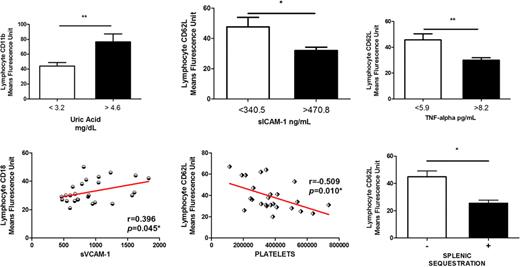Abstract
Abstract 2146
Sickle cell anemia (SCA) is a common, severe monogenetic disorder characterized by chronic hemolysis, frequent infections, chronic inflammatory state and recurrent occlusion of the microcirculation, resulting in painful crises, organ damage and early death. Vaso-occlusive episodes in SCA are complex processes governed by many factors involving interactions between sickle red blood cells, endothelial cells, leukocytes and platelets. The purpose of the present study was investigate circulating lymphocytes from stead-state SCA patients exploring the activation state, response against challenge and its association with hematological parameter, biochemical molecules, soluble adhesion molecules, cytokines expression and medical history. Patients and Methods: We studied 26 SCA patients in steady-state (11 men, 15 women, mean age: 22.65 ± 16.21 years) from Northeast Brazil diagnosed with SCA in attendance of the outpatients clinic of the Foundation of Hematology and Hemotherapy of Bahia (HEMOBA). The control group was compound by 20 healthy Brazilian individuals with hemoglobin AA pattern matched by age, years and ethnic origin. The study was approved by the FIOCRUZ ethical committee and informed consents were signed by patients or official responsible. Soluble adhesion molecule and cytokine were evaluated by ELISA. Hematological analysis and hemoglobin profile were performed using an electronic cell counter and HPLC, respectively. Surface molecules expression on lymphocytes were evaluated by flow cytometry (anti-CD11b, anti-CD18, anti-CD32 and anti-CD62L) on basal state and after LPS challenge and complete medical history was obtained by patients' record. Results: Our results show higher CD11b lymphocyte expression in SCA patients than control group (p<0.05) and lower CD18 lymphocyte expression in SCA patients than control group (p<0.05) on basal and after LPS challenge. After LPS stimulation, we observed an increased expression of CD18, CD32 and CD62L on lymphocyte in SCA (p<0.05), and a decreased CD18 expression on lymphocyte in the control group (p<0.05). Uric acid values above the 75th percentile were associated with an increased expression of CD11b (p<0.05), while sICAM-1 and TNF-alpha values above the 75th percentile were associated with a decreased expression of CD62L (p<0.05). Soluble vascular adhesion molecule was positively correlated with CD18 expression (p<0.05), while platelets were negatively correlated with CD62L expression (p<0.05). Sickle cell anemia patients that developed splenic sequestration exhibited decreased expression of CD62L on lymphocyte surface (p<0.05). Conclusion: The study of lymphocytes surface molecule and its association with markers of inflammation, platelets and soluble adhesion molecules may indicate a differentiated mechanism of these molecules in sickle cell anemia pathogenesis, with a complex involvement of cellular, endothelial and pro-inflammatory interactions. Additional studies should be carried out in order to explore subpopulations of lymphocyte (naïve, effector and memory), once that the presence of CD62L low lymphocytes have been associated with a effector immune response and their contribution on vascular occlusion need to be more explored among sickle cell anemia patients.
Lymphocyte surface molecules association with inflammation markers, soluble adhesion molecules, hematological parameter and medical history of SCA patients. *;** P<0.05.
Lymphocyte surface molecules association with inflammation markers, soluble adhesion molecules, hematological parameter and medical history of SCA patients. *;** P<0.05.
No relevant conflicts of interest to declare.
Author notes
Asterisk with author names denotes non-ASH members.


This feature is available to Subscribers Only
Sign In or Create an Account Close Modal